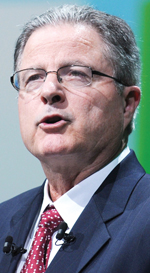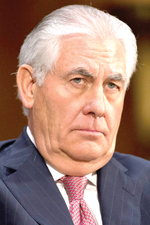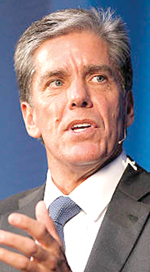Latest update March 21st, 2025 7:03 AM
Latest News
THE RISKY OIL AND GAS SECTOR…ExxonMobil, other companies falsified oil spill capability
Dec 24, 2017 News
…Congressional Panel finds: the only technology used by five companies for oil spill response plan was a photocopying machine
There mere thought of billions of dollars in revenue that will flood the economy from the oil and gas sector can easily make some governments giddy.
But there is an unsettling reality all oil producing nations must face. There are dangers that come with dredging up this black gold that lurks beneath the earth’s surface. Such dangers include environmental disasters like oil spills. The spate of these in recent years has opened up the eyes of concerned citizens in Guyana and the world over.
The infamous Exxon Valdez oil spill which occurred in Alaska on March 24, 1989 is a classic example of this. The Exxon Valdez, an oil tanker owned by Exxon Shipping Company, was bound for Long Beach, California. On its journey, it struck the Prince William Sound’s Bligh Reef and spilled 10.8 million gallons of crude oil for several days.
Critics note that the effects of that oil spill are still felt today. In fact, it is considered to be one of the most devastating human-caused environmental disasters.
But more than 20 years later, many individuals still question whether ExxonMobil actually learned anything from the great Valdez mistake.
On May 1, 2010, a ruptured ExxonMobil pipeline in the state of Akwa Ibom, Nigeria, spilled more than a million gallons of oil into the delta. The leak contaminated waters and coastal settlements in the predominantly fishing communities along Akwa Ibom.
Nigeria’s authorities flagged ExxonMobil for its response to the oil spill as it sought to use certain chemicals which were proven to be toxic to human and marine life.
In fact, Rev. Samuel Ayadi, Akwa Ibom State Chapter Chairman of Artisan Fishermen Association of Nigeria (ARFAN), said that ExxonMobil was in the habit of using dangerous chemical dispersants which are scientifically proven to be toxic to human and aquatic life to clean up oil spills whenever they occur.
He also noted that dispersants were even more dangerous than crude oil because it breaks down the crude oil and sinks it to the sea bed where it affects marine life.
Even as early as February, ExxonMobil found itself under investigation after Australian regulators discovered that there was an oily sheen around ExxonMobil’s rig in the Bass Strait of Australia.
The findings of the investigation revealed that it was indeed an oil spill caused by ExxonMobil and worse yet; its failure to properly respond increased the risk of contamination and posed a “significant threat to the environment.”
OIL SPILL RESPONSE PLANS
Every country is expected to have in its possession, an oil spill response plan that the operator/company would implement in the event of such a disaster.
ExxonMobil will be hitting the start button on production in 2020 and Guyana is yet to see such a document from the company or the Government.
It is important, however, that citizens are given ample opportunity to examine any oil spill response plan which would be submitted by this company.
In that document, ExxonMobil is expected to state the possible worse case scenarios that could occur during an oil spill in Guyana’s waters and how it would respond to it.
But an oil spill response plan does not necessarily mean that a company is fully prepared to deal with such a tragedy.
In 2010, the heads of some of the world’s biggest oil companies were grilled at a congressional panel which focused on the mistakes made in the infamous Gulf of Mexico oil spill.
This was recognized as the worst oil spill in U.S. history.
Within days of the April 20, 2010 explosion and sinking of the Deepwater Horizon oil rig in the Gulf of Mexico, underwater cameras revealed that a pipe was leaking oil and gas on the ocean floor about 42 miles off the coast of Louisiana.
By the time the well was capped on July 15, 2010 (87 days later), an estimated 3.19 million barrels of oil had leaked into the Gulf.
Rex Tillerson, former Chairman and Chief Executive Officer of ExxonMobil, was one of the witnesses. He tried to distance himself from the mistakes of his counterpart, BP Oil Industry Company which was deemed responsible for the spill.
Tillerson had informed the committee that the blowout would not have occurred had ExxonMobil been drilling the well.
Tillerson explained that his company would have done the job differently. But members of the panel were not impressed by his mere words. Tillerson was attacked by some politicians for being unprepared for a similar disaster.
A member of the committee pointed out that ExxonMobil’s oil response plan for the Gulf of Mexico was written by the same contractor used by BP. BP relied on Marine Spill Response Corporation.
The Congressional panel pointed out that the disaster saw a spill of up to 40,000 barrels per day which was overwhelming at that point. Yet, the oil spill response plan for ExxonMobil said that it could effectively deal with 166,000 barrels of oil per day in the worst case scenario.
Tillerson said, “When these things happen we are not well equipped to deal with them…There will be impacts as we are seeing.
“We have never represented anything different than that. And the emphasis has always been on preventing these things from occurring because when they happen we are not well equipped to deal with them,”
At another hearing in 2010, the Energy and Commerce Subcommittee on the Environment in the USA had a session entitled “Drilling Down on America’s Energy Future: Safety, Security, and Clean Energy.”
The hearing came on the heels of the infamous Gulf of Mexico Oil Spill.
The witnesses included Rex Tillerson, former Chairman and Chief Executive Officer of, ExxonMobil; John Watson, Chairman and Chief Executive Officer, Chevron Corporation; James Mulva, Chairman and Chief Executive Officer, ConocoPhillips; Lamar McKay, former President and Chairman, BP America, Inc; Marvin Odum, former President, Shell Oil Company.
The Chairman of the Committee at the time was Representative Edward Markey. Markley noted that the Gulf of Mexico Response Plan by ExxonMobil, Chevron, Conoco Philips and Shell were virtually identical to that of BP’s.
Markey pointed out to Tillerson that like BP on page 116, his plan lists walruses – an animal whose range is confined to the Arctic Region- under sensitive biological and human resources.
“As I am sure you know there aren’t any walruses in the Gulf of Mexico and there have not been for three million years. How can Exxon have walruses in the response plan for the Gulf of Mexico?”
After going around in circles, Tillerson acquiesced that it was unfortunate and embarrassing that that was included. Markey also asked the other companies how they would respond to having walruses in their plan. Like Tillerson, they agreed that it was an unfortunate mistake.
The Chairman also pointed out that in the response plan, there was reference to a Dr. Lutz who is referred to as a technical support person.
However, that person died four years before the plan was even produced by the operators.
Tillerson tried to justify having a person who has been dead for four years in the response plan.
He said that the person may have passed on but the importance of his work did not die with him. Markey then questioned if this is the case, then how one can justify including the phone number of the person in the said response plan.
The Chairman stressed that if this could be done then Tillerson and others could not have taken such a responsibility seriously.
The worrying part was that the other companies had the same person included in their plan. Markley said it would appear that the only technology the operators relied on to put together their response plan was a photocopying machine.
Markey said that there wasn’t enough effort put together to ensure that if an oil spill occurred they would be able to respond. (To see more of this hearing click on this link: https://www.youtube.com/watch?v=aKVMDzqz7zo)
Sources used: https://en.wikipedia.org/wiki/2010_ExxonMobil_oil_spill, http://www.petrocom.gov.gh/assets/Petroleum(Exploration%20and%20Production)Act2016.pdf, https://en.wikipedia.org/wiki/Exxon_Valdez_oil_spill, https://www.theguardian.com/environment/2017/feb/03/oil-spill-near-exxonmobil-drilling-platform-in-bass-strait-to-be-investigated, https://www.theguardian.com/environment/2017/may/10/exxonmobil-criticised-over-response-to-bass-strait-oil-spill.
https://www.youtube.com/watch?v=1dwPUqfDLmQ
https://www.youtube.com/watch?v=WgZf2U3iCs8
https://www.youtube.com/watch?v=aKVMDzqz7zo
https://www.youtube.com/watch?v=zkhKkMO4msc
Share this:
- Click to print (Opens in new window)
- Click to email a link to a friend (Opens in new window)
- Click to share on Facebook (Opens in new window)
- Click to share on WhatsApp (Opens in new window)
- Click to share on Twitter (Opens in new window)
- Click to share on Pinterest (Opens in new window)
- Click to share on Pocket (Opens in new window)
- Click to share on Tumblr (Opens in new window)
- Click to share on Reddit (Opens in new window)
- Click to share on LinkedIn (Opens in new window)
Related
Similar Articles

The Glenn Lall Show|| March, 17th, 2025
Follow on Tik Tok @Glennlall
THE BLUNT OF THE DAY

Sports
Mar 21, 2025
Kaieteur Sports– In a proactive move to foster a safer and more responsible sporting environment, the National Sports Commission (NSC), in collaboration with the Office of the Director of...Features/Columnists
“One Guyana” is no less a national slogan than “Green Guyana”
Kaieteur News- The notion that “One Guyana” is a partisan slogan is pure poppycock. It is a desperate fiction... more
If Guyana’s President Ali is the “Zelensky of the Caribbean”, who is the Putin?
Antigua and Barbuda’s Ambassador to the US and the OAS, Ronald Sanders By Sir Ronald Sanders Kaieteur News- In the latest... more
Publisher’s Note
Freedom of speech is our core value at Kaieteur News. If the letter/e-mail you sent was not published, and you believe that its contents were not libellous, let us know, please contact us by phone or email.
Feel free to send us your comments and/or criticisms.
Contact: 624-6456; 225-8452; 225-8458; 225-8463; 225-8465; 225-8473 or 225-8491.
Or by Email: [email protected] / [email protected]
Weekend Cartoon






















